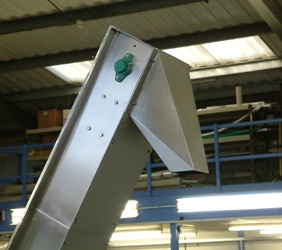Difference between revisions of "Conveyor Chutes"
(Created page with "Category:Conveying{{Knoppen}} <noinclude><!------------------------------------------------ * READ THIS FIRST * Only edit this page if you can improve the content. * Imprope...") |
|||
| Line 7: | Line 7: | ||
* Please start editing this page after the /noinclude | * Please start editing this page after the /noinclude | ||
* -------------------------------------------------></noinclude> | * -------------------------------------------------></noinclude> | ||
[[File:Conveyor-chute.JPG|right|thumb|Conveyor Chutes]] | |||
'''Conveyor chutes''' are used in bulk handling to perform a variety of operations. In particular, the loading of a belt conveyor, and the transfer of material from one moving [[Belt Conveyors]] to another, are important tasks. Such operations are widely used for the transport of both coarse grain material (such as cereals, mineral ore and coal) and fine powders (as used in the chemical and pharmaceutical industries). | |||
Optimal chute design ensures efficient transport without spillage and blockages, and with minimum chute and belt wear. The importance of optimal design is accentuated with the trend towards higher conveying speeds. | |||
To demonstrate the different aspects of the operation of high-speed conveying, the two-belt system shown has been considered.The granular material is initially stored in a rectangular hopper, and is loaded onto the upper belt using a feed chute with lateral skirts. The material is transferred to the lower belt at 90deg. via a transfer chute, comprised of a box containing two curved impact plates. | |||
Latest revision as of 21:29, 22 August 2012
Conveyor chutes are used in bulk handling to perform a variety of operations. In particular, the loading of a belt conveyor, and the transfer of material from one moving Belt Conveyors to another, are important tasks. Such operations are widely used for the transport of both coarse grain material (such as cereals, mineral ore and coal) and fine powders (as used in the chemical and pharmaceutical industries).
Optimal chute design ensures efficient transport without spillage and blockages, and with minimum chute and belt wear. The importance of optimal design is accentuated with the trend towards higher conveying speeds.
To demonstrate the different aspects of the operation of high-speed conveying, the two-belt system shown has been considered.The granular material is initially stored in a rectangular hopper, and is loaded onto the upper belt using a feed chute with lateral skirts. The material is transferred to the lower belt at 90deg. via a transfer chute, comprised of a box containing two curved impact plates.
